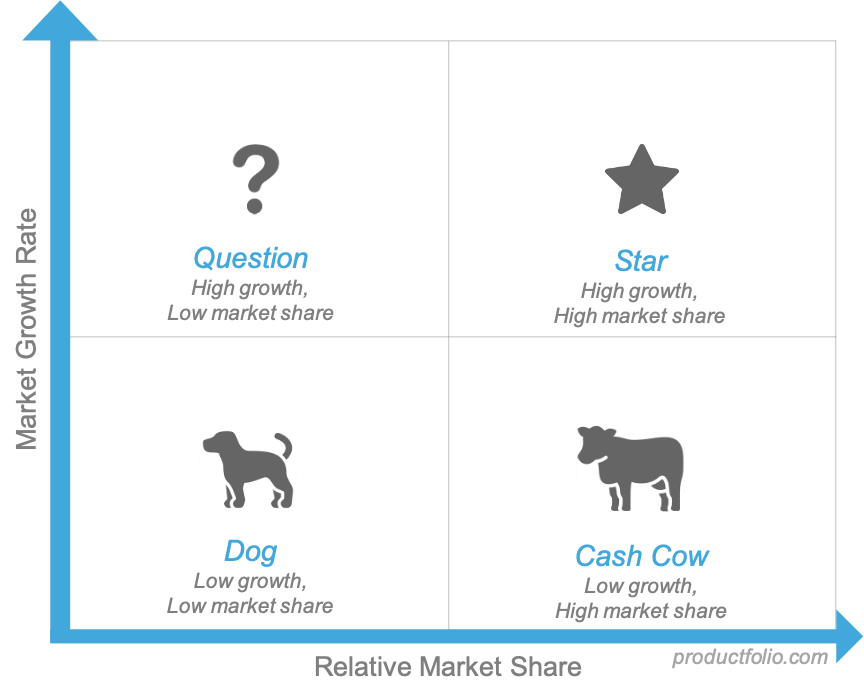Competitive Analysis Frameworks
C
A competitive analysis framework is a structured approach used by businesses to evaluate and understand their competitive landscape. It involves assessing the strengths and weaknesses of both direct and indirect competitors to gain insights that can inform strategic decision-making. The goal of a competitive analysis is to identify opportunities and threats in the market, allowing a company to position itself effectively and gain a competitive advantage.
There are several benefits from competitive analysis. Here are a few of our favorites:
1. Porter’s Five Forces
A popular competitive analysis framework credited to Michael Porter, this model draws attention not only to existing competitors but also to those that might join the fray at some point.

Porter’s Five Forces refers to five elements that influence the extent of competition you’d have to contend with in your industry or market. The forces are:
- Competitive rivalry
- Bargaining power of suppliers
- Bargaining power of buyers
- Threat of new entrants
- Threat of substitutes
This model will be especially useful when entering a new market. It helps you to get valuable information on the nature or extent of competition in your target industry. Evaluation of these elements can guide you on the proper approach to use for establishing a firm foothold.
2. SWOT Analysis
Here is a widely-used framework when it comes to how to improve competitiveness in diverse industries. The name is an acronym for Strengths, Weaknesses, Opportunities, and Threats. Like Porter’s Five Forces, it identifies some key factors to consider when looking to gain a competitive advantage. You guide your decisions by evaluating those factors to see if they are worth making at all.
In marketing, SWOT analysis most times falls under competitive landscape analysis (CLA). Agencies use the model to assess their clients in relation to the competition to suggest what they can do better.

3. Growth-Share Analysis (BCG Matrix)
Developed by Boston Consulting Group’s Bruce D. Henderson, the growth-share matrix is a framework that helps companies to evaluate their business units. The tool assists in making the decision of what to keep, put more money in, or ditch.

This model is useful for classifying products in your portfolio based on realities in your industry. It makes it easier to determine what is worth giving more priority. The growth-share matrix has four quadrants in which you classify products or business units, marked as follows:
Stars – This is the group of products with a potential for high growth and market share, thereby justifying further investment.
Question marks – Products, usually new ones, that have a high growth rate but low market share. A decision on whether to invest more in them will depend on your conviction of them going on to become stars.
Cash cows – Here you have products that have high market share but low growth. Funds to invest in pushing “stars” usually come from them.
Dogs or Pets – These are products with low growth and low market share. You can choose to dump or reposition them.
The growth-share matrix is more suitable for big organizations with large portfolios. You can also apply it to the analysis of marketing channels, among others.
Strategic Group Analysis
Also known simply as SGA, this framework is an attempt to group organizations according to their strategies or bases of competition. Companies with similar strategies are arranged in clusters for analysis. It requires first making out key characteristics that form the basis of competition.
The model reduces the number of firms in an industry to groups based on strategic dimensions for easier comparison. It enables you to identify the cluster your organization belongs to or your position in the competitive environment. It allows you to self-assess in relation to other players in the industry.
As an example, SGA can let you know other firms that adopt a similar pricing strategy or marketing approach as you. This knowledge can guide what you do to gain an advantage.
4. The 5 C’s Framework
The 5C’s framework is a strategic management tool used for analyzing the internal and external factors that can impact an organization. This framework provides a comprehensive view of the key elements that influence a company’s performance and decision-making. The 5C’s typically include:
Company: This refers to an in-depth analysis of the internal factors within the organization. It involves evaluating the company’s strengths and weaknesses, understanding its resources, capabilities, and overall strategic position. This includes assessing the company’s financial health, organizational structure, management team, and existing processes.
Customers: Understanding the needs, preferences, and behaviors of customers is crucial for any business. This aspect involves market segmentation, identifying target customer groups, and analyzing their buying patterns. It helps businesses tailor their products or services to meet customer demands and enhance customer satisfaction and loyalty.
Competitors: Analyzing the competitive landscape is essential for strategic planning. This involves identifying direct and indirect competitors, understanding their strengths and weaknesses, and evaluating their strategies. A competitive analysis helps organizations position themselves effectively, identify market opportunities, and develop strategies to gain a competitive advantage.
Collaborators (or Partners): Collaborators or partners include entities that work with the organization to achieve common goals. This can involve suppliers, distributors, alliances, or any other external entities that contribute to the company’s success. Understanding and managing relationships with collaborators is vital for ensuring a smooth and efficient value chain.
Climate (or Context): The external environment, often referred to as the business climate or context, encompasses various factors that are beyond the organization’s control. This includes economic conditions, technological advancements, legal and regulatory factors, socio-cultural trends, and more. Analyzing the external environment helps organizations anticipate challenges and opportunities and adjust their strategies accordingly.
By systematically examining these five dimensions, the 5C’s framework provides a holistic view of the factors that can influence an organization’s success. This analysis aids in strategic decision-making, allowing businesses to align their internal capabilities with external opportunities and challenges. The 5C’s framework is widely used in marketing, business planning, and overall strategic management processes.